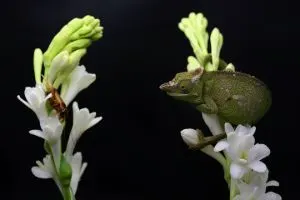Fischer’s Chameleon care requires a very specific environment and tall enclosures for a proper upbringing. It is tough for them to thrive in captivity without these specific conditions, which is why we don’t usually recommend them as a pet for first-timers.
You must be ready to be attentive to all your chameleon’s needs, which means you want to do proper research before even considering getting one.
We don’t recommend letting a child care for a chameleon, as they are not child-friendly pets with all of their needs. An adult should be the one caring for this kind of pet and if a child is going to handle it, they should be supervised by an adult.
Many people find chameleons interesting due to their ability to change color, but not many people understand the concept or know why or how they can do so.
It’s a common misconception that they do it to camouflage themselves against their environment to hide from predators, but that is actually not the case. In reality, chameleons will change their color to regulate their body temperature or communicate.
To maintain a favorable body temperature, chameleons will grow darker in color to absorb more heat in cold temperatures and will turn paler to reflect the sun’s heat in hotter temperatures. This is called thermoregulation.
They might be changing color to woo a possible mate, males might do it to signal at other males to stay away, and females might use their color change to show interest in mating.
So how do chameleons change color?
Under most chameleon’s transparent outer layer of skin sits two laters of specialized cells. The layer beneath the outermost layer contains chromatophores and the layer below that are guanophores, the second cell layer.
Chromatophores contain yellow and red pigments, whereas guanophores have a colorless crystalline matter we call ‘guanine’. Guanophores reflect the blue of incident light meaning that if the upper layer of chromatophores is yellow in color, the reflected light will be green.
They also have a layer of dark melanin-containing cells called melanophores located even deeper below the two layers of cells we just explained. These will influence the color and lightness of the reflected light.
Now that we have covered some basics about Fischer’s Chameleon, let’s talk more about the more important things and how to care for them properly.
Fischer’s Chameleon Facts

- Experience Level: Intermediate
- Scientific Name: Kinyongia fischeri
- Other Names: Western Usambara Two-horned Chameleon, Two-horned Chameleon, Monkey-tailed Fischer’s Chameleon
- Family: Chamaeleonidae
- Size: Average 9.5 inches
- Weight: 3.6 to 5.5 ounces
- Diet: Carnivorous
- Lifespan: Varied anywhere from 2 to 20 years; typically 5+ years in captivity with proper care
Chameleons can rotate their eyes separately on a 180-degree arc, giving them a 360-degree field of vision.
Fischer’s Chameleons species come with both dwarf and giant versions; adult dwarfs growing up to 8 inches long and giants growing up to 16 inches. An average Fischer’s is typically 9.5 inches.
They are sometimes called Monkey Tails due to their unusually long tails.
Fischer’s Chameleon Appearance

These chameleons are typically a bright, leaf green with lime green or clay-tan colored striped markings on their back. Some individuals may appear more brown or olive to the eye as well.
They have two distinctive horns protruding out of their face, almost like a long nose. These horns will typically be a mud-colored tan or in a few individuals, a faded lime green color as well.
Males will typically be bigger than their female counterparts.
This species actually comes with both dwarf and giant versions, adult dwarfs growing up to 8 inches long and giants growing up to 16 inches.
The average Fischer’s Chameleon is typically 9.5 inches.
Fischer’s Chameleon Location and Natural Habitat
Fischer’s Chameleons can be found in Tanzania as well as their neighboring country, Kenya. Although the ones in Kenya have now been classified as a different species.
They prefer hilly forests, where they can camouflage into the environment with their bright greens.
They are almost threatened due to their small geographical range. They mostly stick to the Nguru and Nguu Mountains of Tanzania, but can also be found in parts of the Eastern Arc Mountains towards Tanzania’s neighbor, Kenya.
Fischer’s Chameleon Diet

Fischer’s Chameleons feed on various different types of insects in the wild such as giant mealworms, roaches, and crickets. They will also eat the occasional pinky mouse.
Since chameleons cannot hear very well, they will use air vibrations and low-pitched noises to figure out where their prey is.
Many reptiles possess the Jacobsen’s organ, which is right where you’d expect their nose to be and gives them the ability to smell chemical particles. In chameleons, however, this organ is a lot more reduced in its ability to smell. This leaves them to use their other senses when catching their prey.
When prey is in sight, they catch it by first focusing their eyes on their target, then shooting their tongue out of their mouth to grab it.
Fischer’s Chameleon Lifespan
Their lifespan in the wild varies anywhere from 2 to 20 years, but they will typically live about 5 years in captivity with proper care.
As we mentioned, caring for them can be quite difficult, so there is no sure answer on how long they will live.
Fischer’s Chameleon Breeding Habits

The Jacobson’s organ, which we just mentioned in the last section, is also used for communicating readiness for mating between the same species through the release of chemical messages.
If you are attempting to mate your chameleons, it is important that you remove the male as soon as copulation is completed because the female is highly likely to attack the male right after mating.
Fischer’s Chameleons typically have a clutch size of around 10 to 15 eggs and after laying them, females become inclined to bury them as deep under the soil as they can, which is usually around 12 inches deep.
If your female Fischer’s does this, be sure to help her pack the soil down carefully, but firmly, after she lays them.
Incubation periods are typically a year or so for this species, and you want to incubate the eggs at temperatures around 67 degrees Fahrenheit.
Predators of the Fischer’s Chameleon
Common predators of chameleons in these areas include birds, snakes, and other mammals.
Fischer’s Chameleon Legality

Most chameleons are illegal to take from the wild, especially those classified as a Prohibited Dealing animal under the Biosecurity Act 2015, specifically listing Veiled Chameleons, Panther Chameleons, Jackson’s chameleons, and other common chameleon species.
However, most are allowed to be kept as pets, bred, and sold in all states except Maine as long as you have a permit, also known as CITES papers.
Where to Buy Fischer’s Chameleons
It is important that you find captive-bred chameleons because most wild-caught chameleons will, unfortunately, carry parasites and may also have stress-related illnesses. We recommend that you avoid getting a wild-caught chameleon.
It is crucial that you are doing your research and finding a reputable breeder or pet shop. Take your time to watch its movements and actions before going through with the deal to make sure that it is a healthy chameleon.
Indicators of an unhealthy chameleon you might want to keep an eye out for are if it is refusing food, has excess mucus around its mouth or nasal passages, or cloudy eyes. These could be signs of infection or just an overall unhealthy lizard.
You should also pay attention to their skin and color. If you see many dry patches, it could be an indicator that the breeder or shop is not taking care of them well or that the chameleon is sick.
We hope that before you purchase your chameleon that you are mentally and financially prepared to take care of all their needs.
A chameleon may be priced anywhere from $30 to $300 depending on the shop you’re buying from, age, and its species.
A typical price range for Fischer’s Chameleons should be around $100 to $300 for the chameleon itself, not including all the things you will need to feed or care for your pet.
Fischer’s Chameleon Care Guide

Enclosure
For this chameleon, a mesh or screen enclosure is the best option. While they thrive under more humid conditions, they also need a good amount of ventilation.
A single adult chameleon should not be housed in an enclosure any less than 24 by 24 inches wide by 36 inches tall but the bigger the better. They require taller enclosures since they are avid climbers.
Make sure there is an easy-to-access cage opening since you will need to frequently spritz their environment unless you are going to install a misting system.
They require high humidity, which can be troublesome to maintain with a mesh cage, but they also need proper ventilation. This is where foggers, drippers, and automatic misting systems come in handy.
Again, the bigger the space, the more they will thrive. They need room to roam around, climb, and hide from prying eyes.
Cleaning
In order to keep your pet chameleon healthy, you should put the effort into daily cleaning and upkeep to maintain a fresh environment.
There is something call spot cleaning, which you should be doing daily like cleaning out any fecal matter, leftover food, and such.
Here is a good video that you can use as an example:
Any substrates or other decorations should be changed or cleaned on a weekly basis and you should do a full deep cleaning once or twice a year. A full cleaning consists of emptying out their whole enclosure and disinfecting it completely.
Substrate
While most owners will simply use newspaper or reptile carpet, which is totally suitable and a lot easier to clean.
However, if you prefer the look of a natural or particulate substrate, be sure to avoid using those with small particles such as sand or cat litter. Avoid gravel, cedar, corn cob bedding, and any other beddings that might hold too much excess moisture, causing rot.
You should not have to have a floor substrate to plant any of their climbing plants. Those can be kept in a pot at the bottom of their tank.
In most cases, your chameleon won’t have any need for a substrate.
Temperature

Fischer’s Chameleons thrive at a wide range of temperatures and will usually move around to thermoregulate. As their owner, you must provide them with all their required temperatures at different parts of the tank.
Install good thermometers that can help you measure and make sure their temperatures are at the optimal range for their comfort.
At the top of the cage, it should be at higher temperatures of 90 degrees Fahrenheit and the bottom of the cage should be 80 degrees Fahrenheit.
At night, be sure that their temperatures are around 65 to 70 degrees Fahrenheit to make their home feel more natural. Be sure not to let their tank go anywhere below 65 degrees.
These numbers are the most ideal for your pet Fischer’s Chameleon.
Humidity
While humid conditions are important for their survival, good ventilation is even more important. This is why a mesh cage is recommended, to ensure good airflow throughout their environment.
While it is difficult to keep humidity with this type of cage, it is still crucial to try to monitor and keep their humidity around the recommended numbers. This can be done through misting systems or manually spraying their tank multiple times a day.
For Fischer’s Chameleons, you need to keep their enclosure at around 75 to 85 percent humidity throughout the day.
A hygrometer should be installed into your pet’s enclosure so that you can check their humidity instantly.
Lighting

Just like any chameleon, Fischer’s Chameleons need full-spectrum UVB lighting.
A popular choice for chameleon enclosures is the 60-watt bulb. You should also install a thermometer within their enclosure to keep a close eye on their temperatures.
You can also achieve proper heat by using strip lights.
Your heat lights will be responsible for keeping your enclosure and basking area at appropriate temperatures.
You also must have a proper basking light for your chameleon. Mercury Vapor Bulbs are a great option that will provide both suitable heat and UVB without having to install multiple fixtures in a large enough cage.
Let’s talk about the importance of UVB lighting, shall we?
This special light is crucial for your chameleon’s health since it will technically be a substitute for natural sunlight. UVB will help increase your pet’s metabolism, activity, appetite, and will also synthesize Vitamin D3, a crucial vitamin needed for proper calcium absorption.
Without UVB lighting, you run the risk of your chameleon developing Metabolic Bone Disease, which will stunt their growth, causing them to suffer from weakened bones.
Be sure to keep their UVB lamp unfiltered and at least 12 inches away from the highest point in their cage to prevent thermal burns.
They will need plenty of UVB so get yourself a UUVB fluorescent bulb and install it for them. We suggest you keep this on for 12 hours a day then off again for 12 hours at night to keep your pet on a natural routine.
Accessories
These chameleons are great climbers and love hiding in lush foliage.
The most important thing when it comes to choosing your plants is that they are pesticide-free and non-toxic. A good rule of thumb is to use a mix of fake and real plants, if possible without any need for a substrate.
You want tall, potted plants that aren’t too colorful, as too much color can sometimes stress chameleons out.
Fiscus trees work well for Fischer’s Chameleons as well as some branching wood pieces for perching at various heights and temperature ranges. Fake vines, some magnetic plants, and other foliage can also help create a more natural jungle environment for your pet.
Feeding

In captivity, you can feed your Fischer’s Chameleon giant mealworms, crickets, roaches, and other gut-loaded lizard-friendly insects available at pet stores. This species will also enjoy it if you give them the occasional pinky mouse as a treat.
Be sure to dust their prey with calcium powder, another crucial part of their health.
You can feed your adult chameleon 5 to 7 large bugs every other day and younger Fischer’s can eat daily. Put their insect prey up in their foliage or into an elevated dish for them to reach at.
Be sure to remove any uneaten prey after about 10 minutes because leaving them in the enclosure can cause them to bite your chameleon, which can lead to bites susceptible to infection.
Water
Chameleons don’t drink from water bowls and prefer to lick droplets from leaves, other foliage, and even the sides of their cage.
Whether you decide to go with a drip system or the manual spraying method, make sure you get the leaves really good. You will want to spray their cage around 3 times a day.
You can tell that your chameleon might be dehydrated if their feces are dry, their urate is orange or yellow, their skin seems to be folding, their eyes look sunken, they are acting lethargic, and are showing signs of a loss of appetite.
Temperament

Fischer’s Chameleons are highly active lizards and have been described as ‘amusing’ or ‘comical’ animals.
While they are pretty indifferent towards humans, most chameleons typically do not like being handled but can learn to tolerate it with patience and practice.
These shy creatures need to be housed individually since they can become territorial, especially males. Being around other chameleons makes them nervous, causing them to stress out, become territorial, and fight.
Handling
These shy, delicate chameleons prefer to be in their enclosure, climbing their vines and foliage, and would much prefer not being handled.
If you attempt to handle your chameleon, they might become extremely stressed out. While they can eventually become accustomed to handling, they do not actually enjoy it, so we really don’t recommend it.
Just enjoy their beauty in seeing them grow healthy and watching their unique selves move around. Let them climb, bask, and hide in peace!
Fischer’s Chameleon FAQ

What do Fischer’s Chameleons eat?
In the wild, they pretty much eat the same things as they would in captivity. This includes giant mealworms, crickets, and roaches.
In captivity, you will want to gut-load their prey insects and brush them with calcium powder before feeding it to them.
How big does a Fischer’s Chameleon get?
An average Fischer’s Chameleon is typically 9.5 inches.
This species comes in both dwarf and giant versions, adult dwarfs growing up to 8 inches long and giants growing up to 16 inches.
A lot of their length will come from their long tails.
How big do dwarf Fischer’s Chameleons get?
Dwarf Fischer’s Chameleons can grow up to 8 inches in length, and that is at their adult size. Females will typically be slightly smaller than their male counterparts.
Conclusion
Fischer’s Chameleons can truly be rewarding pets to have if you are prepared to care for their needs and have done the research needed to help them thrive well in captivity.
As mentioned earlier, they are not beginner-friendly pets because of their particular needs but can be great for the intermediate keeper.
We hope that you learned something about caring for Fischer’s Chameleons from this article that you can put to use if you decide to get one.
Leave a comment below if you have any more questions for us!
More Chameleon Stuff
- Best pet chameleons
- How much do chameleons cost?
- Why do chameleons change color?
- Panther Chameleon care sheet
- Flap necked Chameleon care sheet
- Senegal Chameleon care sheet
- Carpet Chameleon care sheet
- Oustalet’s Chameleon care sheet
- Meller’s Chameleon care sheet
- Four-horned Chameleon care sheet
- Veiled Chameleon care sheet
Table of Contents
